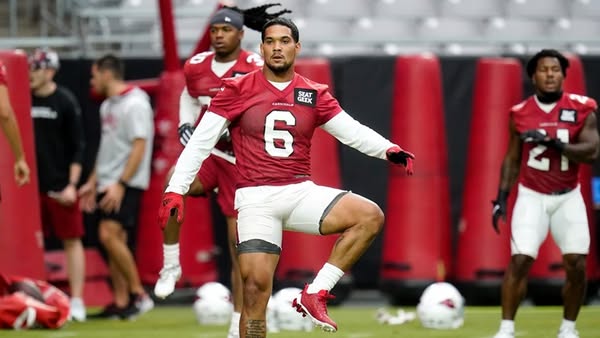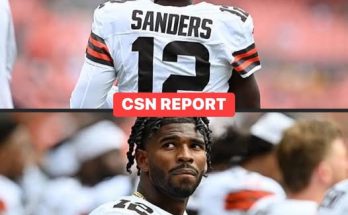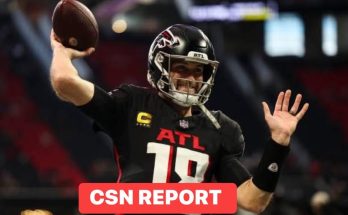Day 2 of Cardinals Training Camp Concludes on a Somber Note, With Key Takeaways Highlighting Concerns or Setbacks
The second day of the Arizona Cardinals’ 2025 training camp came to a close under a cloud—both figuratively and literally. What began as a routine day filled with excitement and optimism gradually turned into one marked by tension, disappointment, and growing concern. While training camp is often viewed as a time of hope, discovery, and momentum-building, Day 2 served as a sharp reminder of the obstacles this franchise still faces as it tries to emerge from a prolonged period of inconsistency and underperformance.
Though it’s far too early in the preseason to push the panic button, the red flags raised during this session cannot be ignored. Whether it’s injuries, performance struggles, or continued issues with execution and chemistry, the concerns from the second day of camp paint a sobering picture of the challenges still ahead for this team.
The most immediate and alarming development was the injury to wide receiver Michael Wilson. During 11-on-11 drills, Wilson went up for a contested catch across the middle and came down awkwardly. He stayed on the ground, clutching his knee before being helped off the field by trainers. There was no immediate official word on the severity of the injury, but his absence cast a noticeable shadow over the remainder of practice.
Wilson, who showed promise during his rookie season in 2024, was expected to take on a larger role this year as the team’s likely WR2 behind Marvin Harrison Jr. His combination of size, hands, and route-running gave the Cardinals a much-needed physical presence in the passing game. Losing him for any stretch of time would be a major blow to an already thin and uncertain wide receiver corps.
Beyond Wilson, the wide receiver group as a whole struggled throughout the session. Drops plagued the unit in both individual and team drills. Even top rookie Marvin Harrison Jr. had a few uncharacteristic missteps, including a misread on a hot route and a drop on what should’ve been a routine slant catch. The rest of the receivers failed to separate consistently, and the timing between the pass-catchers and quarterback Kyler Murray appeared off for most of the afternoon.
Speaking of Murray, his Day 2 performance left plenty of room for improvement. After a solid showing on Day 1, he appeared out of rhythm and frustrated on several occasions. A combination of inaccurate throws, miscommunication with receivers, and heavy pressure from the defensive front resulted in a stalled offense that failed to move the chains during full-team situational drills.
One particular sequence summed up the offense’s struggles. During a red zone drill, Murray was flushed from the pocket on three straight plays. On the first, he overthrew tight end Trey McBride on a corner route. On the second, he was forced to throw the ball away under duress. On the third, he was “sacked” (touch sack in camp terms) before a play could develop. His body language suggested frustration, and for a quarterback trying to return to elite form, that kind of mental wear is concerning even in the early stages of camp.
To be fair, some of that pressure stemmed from strong play by the defensive line, which has looked fast and aggressive through the first two days. Rookie edge rusher Darius Robinson and second-year linebacker BJ Ojulari both flashed with multiple pressures and would-be sacks. However, while their energy is encouraging, it also points to a potential weakness in the offensive line.
Arizona’s offensive front—an area that needed to improve drastically from last season—did little to ease concerns. Veteran linemen struggled to hold their blocks, and even basic stunts and blitz packages gave them trouble. There were multiple false start penalties and miscommunications, including one exchange where the center snapped the ball before Murray was ready. Chemistry, technique, and consistency all appear to be works in progress.
The backfield didn’t fare much better. Running backs James Conner and Emari Demercado had a hard time finding running lanes. The run-blocking left much to be desired, with defensive tackles frequently getting penetration. This forced the backs into making lateral movements before hitting the line of scrimmage, neutralizing their impact. There was also a fumble during a handoff exchange, leading to a sharp conversation between Conner and the offensive line coach.
Defensively, while the unit showed encouraging signs of cohesion, they weren’t immune to setbacks. Linebacker Zaven Collins appeared to tweak his ankle during position drills and was limited for the rest of practice. Though it did not appear serious, any time missed during training camp can impact conditioning and install progress, especially for a defense trying to bounce back from a rough 2024 campaign.
Another point of concern was the secondary, particularly in man coverage situations. Cornerbacks struggled to keep up with speedier receivers, and there were a few instances where receivers got open deep—only to be missed by the quarterback. While the pass rush masked some of the deficiencies, it’s clear the defensive backfield is still searching for a reliable rotation and leadership behind Budda Baker.
The coaching staff, to their credit, remained composed but firm throughout the session. Head coach Jonathan Gannon addressed the team afterward in a huddle that lasted longer than usual. Though details of the message were not disclosed, players exiting the field looked visibly frustrated, especially on the offensive side. It was not the kind of session that builds confidence. It was the kind that tests it.
Special teams were also uneven. Kicker Matt Prater missed two field goals from mid-range, one of them sailing wide right after a bad hold. Return drills were marked by poor ball security, with a muffed punt by a backup return man and another near fumble on a kickoff. These may seem like minor issues in July, but special teams miscues often become costly in close games when the season begins.
For a team already facing questions about depth, chemistry, and execution, the setbacks on Day 2 reinforce the uphill battle Arizona faces. The absence of a clear identity, both offensively and defensively, was evident. Players appeared unsure at times, lacking the sharpness and tempo typically expected at this stage of camp.
Of course, it’s important to keep perspective. Training camp is a process, and teams often experience bumps early as they install schemes, integrate new players, and reacclimate to football speed. But for a franchise that has endured back-to-back losing seasons, morale is fragile. Each dropped pass, each blown assignment, and each injury amplifies the pressure to prove that better days are ahead.
Injuries will need to be monitored closely. The team has already lost key contributors to IR in past seasons, and depth remains a critical issue. If players like Michael Wilson or Zaven Collins are forced to miss extended time, it will test the limits of Arizona’s roster and coaching creativity.
Heading into Day 3, the Cardinals will need to refocus and regroup. Improvement is not only desired—it’s necessary. The team must quickly identify and correct communication breakdowns, sharpen fundamentals, and reignite the competitive spirit that has felt lacking through the first two sessions. Players like Kyler Murray, Marvin Harrison Jr., and Budda Baker must lead by example and help set the tone for the rest of the camp.
Day 2 ended not with cheers but with uncertainty. The hope is that the adversity faced now can serve as fuel for growth, bonding, and eventual success. But that will require resilience, accountability, and a recommitment to fundamentals across the board.
For now, the Arizona Cardinals find themselves at an early inflection point. They have talent, but that talent must be refined. They have promise, but that promise must be realized. And most of all, they have a fan base that is watching closely—hoping, once again, that this team can find its way back to relevance.
The work continues. But Day 2 served as a reminder that the path forward won’t be easy. It will require more than just potential. It will require answers. And they’ll need to come soon.



